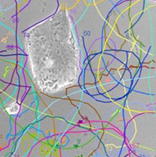Bacterial Swimming Modelling
Bacterial swimming modeling in infectious processes.

Motility characterizes a certain number of pathogenic bacteria (EHEC, Salmonella, Vibrio, etc.) and is a key element in the ability of a bacterium to reach the host cell, infect it and then spread through the body. Despite its importance, the impact of pathogen mobility on the infectious process remains poorly understood. In a series of recent works, we have developed the first mathematical model that link bacterial motility with infectivity.
The aim of this project is to establish an interdisciplinary approach that combines mathematical modeling with experimental observations, a law for the temporal evolution of the number of pathogenic bacteria in the infected organism as a function of bacterial motility parameters. These motility parameters are strongly modified by the physical characteristics of the environment (e.g. mucus) and the adhesion properties of bacteria to surfaces. A better knowledge of the bacterial motility-infectiousness relationship will allow on the one hand to better understand the infectious mechanisms and opens a new therapeutic avenue which aims to reduce the accessibility of target cells to bacteria.
This project is the result of a collaboration between the Scientific Center of Monaco (CSM) and the Jean Alexandre Dieudonné Laboratory (LJAD) of the Côte d'Azur University.
Teams involved in the project "Bacterial Swimming Modelling":
CSM: Team "Ecosystèmes et Immunité": Dorota Czerucka and Rodolphe Pontier-Bres
UCA : JA Dieudonné Laboratory, Fernando Peruani team.
Collaborative articles:
- Bacteria display optimal transport near surfaces | Nature Physics
- Statistics of pathogenic bacteria in the search of host cells | Nature Communications
To know more about this project, check out this video!

